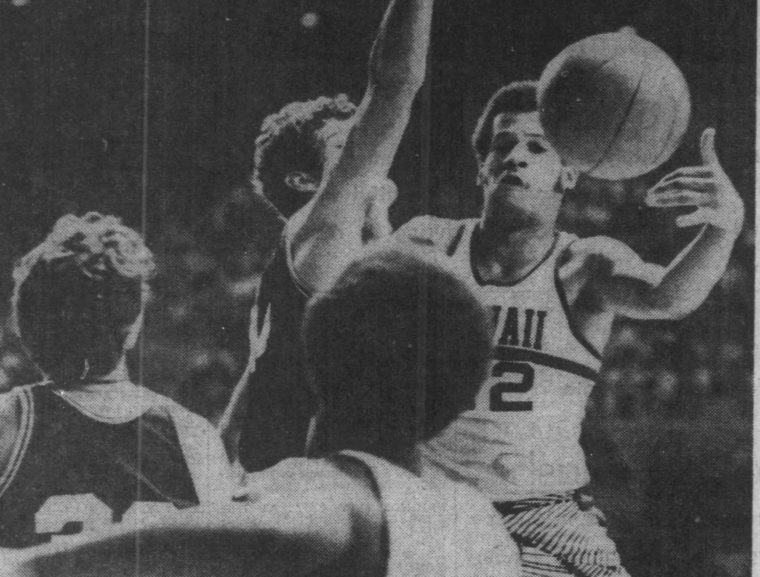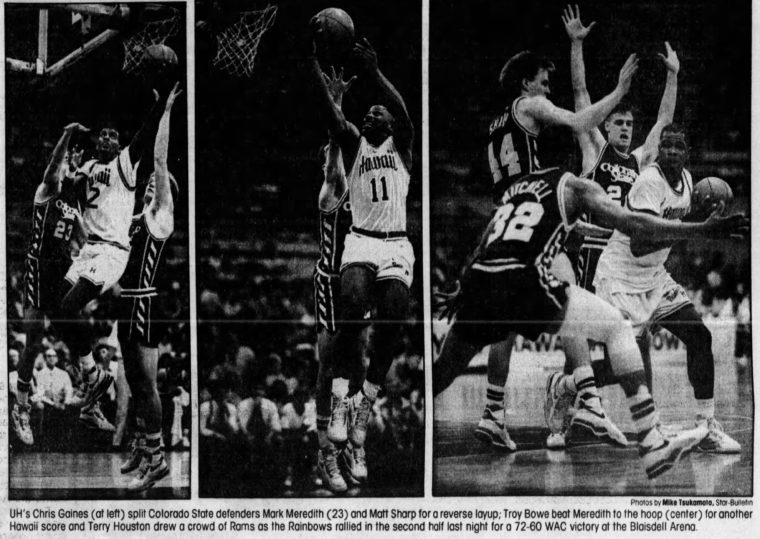Hawaii men’s basketball: 100th Season Best-Team Bracket, Elite Eight, Day 4

Can Hawaii’s all-time leading scorer prevent the Hawaii basketball 100th Season Best-Team Bracket from coming down to a matchup of the top four seeds?
Chris Gaines and the hard-nosed NIT quarterfinal team of 1989-90 will have their work cut out for them against the second-seeded, inaugural NCAA Tournament team of 1971-72. One “Fabulous Five” team has already been knocked out; doubtless Bob Nash and Co. are motivated to move on to the final weekend.
So far, the voters have selected the higher seed in every matchup.
On Saturday, No. 3 2001-02 survived a spirited matchup with No. 6 1996-97, winning by a differential of 56.1% to 43.9%.

Voting begins at 9 a.m. (HST) on Twitter. You can vote below, or directly on the Warrior World Twitter page.
On to today’s matchup:
>> No. 7 1989-90 (25-10, NIT quarterfinals)


This crew started the season 10-1 — with the lone loss to Kansas State in the Great Alaska Shootout — before losing 87-75 to Duke. Yes, Christian Laettner and Bobby Hurley were just pups, but they did go to the NCAA championship game three months later, and UH gave them all they could handle in the final of the Rainbow Classic; All-WAC first-team guard Chris Gaines kept UH in it with a game-high 26 points, but Duke pulled away in the closing minutes. Throughout the season, led by guards Gaines, Troy Bowe and Phil Lott and a front line of Terry Houston, Vincent Smalls and Cliff Beaubrun, the Rainbows were not flamboyant or statistically impressive as a unit. But they were gritty, especially in tournaments. They went 10-6 in the WAC regular season, tying for third, and made it to the WAC tournament final, then came within one win of the NIT semifinals and Madison Square Garden (after wins against Stanford, 69-57, and a strong Long Beach State squad, 84-79, at the Blaisdell). However, UTEP at the Haskins Center in the WAC tourney and New Mexico at The Pit in the NIT quarters were too much to overcome. Despite that, it was a season of redemption for the late Gaines, who after missing the spring semester of his junior season due to academic ineligibility, came back strong and scored a then-record 616 total points in the season (17.6 per game) to become UH’s all-time leading scorer at 1,734, surpassing Fabulous Fiver John Penebacker (1,519). His season points stand at No. 2 now, behind only the 626 of Anthony Harris in 1995-96. While not a gifted 3-point shooter — Gaines shot .303 from distance for his career — he converted 47.9% for his four-year tenure from the field, most impressive for a guard. He got to the line often, too, and converted a UH career-record 84.8 percent of those attempts to become the all-time free-throw maker (442) as well. UH set a record for wins in a season that would last 12 years.
Roster: Beaubrun, Arlen Bento, Bowe, Gaines, Mike Gilless, Houston, Joe Hudson, Jim Lactaoen, Lott, Andrew McGuire, Wendall Navalta, Bob Robinson, Tim Shepherd, Smalls.
VS.
>> No. 2 1971-72 (24-3, NCAA first round)


The Fabulous Five returned intact after its electrifying 23-5 debut of 1970-71, and the second edition was just as thrilling — crowds responded with fervor and the 7,500-seat Blaisdell Arena (then called the Honolulu International Center) sold out 19 times in 19 home games. This time 6-foot-8 Bob Nash was the leading scorer (18.2) and rebounder (14.4), swapped from 6-7 big man Al Davis (18.9) the season before. “Little General” Jerome Freeman (5.3 assists per game), at 5-9, was team captain for the second straight year. John Penebacker (13.9 ppg), a 25-year-old Air Force veteran and 6-2 leaping pivotman, and 6-4 speed merchant Dwight Holiday (16.7) remained highly productive. Subs like Todd Huber, Mike Kendall and Artie Wilson contributed. UH’s first NCAA Tournament team went 19-0 at home and 5-2 on the road in the regular season, with the lone losses by 10 points at Loyola Marymount and one point at Westmont. Coach Red Rocha’s squad, even with the quicker pace of play in this era, averaged a ridiculous 91.7 points per game, which easily remains the program record. The ‘Bows bested eventual national runner-up Florida State twice at home, including once by forfeit when Seminoles coach Hugh Durham refused to walk off the court after getting ejected with his team trailing 30-10. FSU was No. 9 and No. 14 for those two matchups; UH was previously 0-23 all-time against Associated Press ranked teams. That helped vault UH into the rankings for the first time in program history, at No. 18. UH remained in the top 20 the rest of the season, cresting at a program all-time best No. 12 on March 7. It built up to UH’s inaugural NCAA meeting with 17-9 Weber State in Pocatello, Idaho, for the right to play Bill Walton and Coach John Wooden’s eventual six-time national champion UCLA team in the second round of the 25-team field. But favored Hawaii was crushed by the Wildcats, 91-64, with Nash held to seven points against a 2-1-2 zone defense and Bob Davis going off for 32 for the Wildcats. … It was far from the end for Nash, though, as he was drafted by the Detroit Pistons with the ninth overall selection of the NBA Draft, and also played with Kansas City in the NBA. He later was an assistant and head coach at UH and his jersey (No. 33) was retired in 2020. Nash’s sublime rebounding average remains the single-season record, and he owns the career average mark as well (13.6). His legendary 30-board game against Arizona State in the 1971 Rainbow Classic championship is another mark that won’t be bested anytime soon — the exclamation point for UH’s first All-American, who also became the first to average a double-double for a season. Davis would leave with a 17.1 scoring average for his two-year Rainbows career, setting the benchmark in the all-college opponent era. He remains fourth all-time in average. The Fabulous Five lived on as a unit, often returning to Hawaii for exhibitions and reunions. UH’s 49-8 record during the “Fabulous Five” era remains the best in winning percentage (.860) for UH over any two-year span.
Roster: Mike Blackshire, Tyrone Bradshaw, Davis, Freeman, Holiday, Huber, Kendall, Nash, Penebacker, Mark Skillicorn, Jim Wienstroer, Charlie Williams, Wilson.
Day 4 of the #HawaiiMBB 100th season Best-Team Bracket Elite Eight is underway.
>> No. 7, 1989-90 (Chris Gaines, Terry Houston, Phil Lott)
VS.
>> No. 2, 1971-72 (Bob Nash, John Penebacker, Dwight Holiday)
Info/rosters for both teams here: https://t.co/UTXwLCrrDa
— Hawaii Warrior World (@hawaiiwworld) March 29, 2020
——————
Brian McInnis and Dave Reardon assembled the season summaries. Curtis Murayama designed the 100th season bracket.
COMMENTS